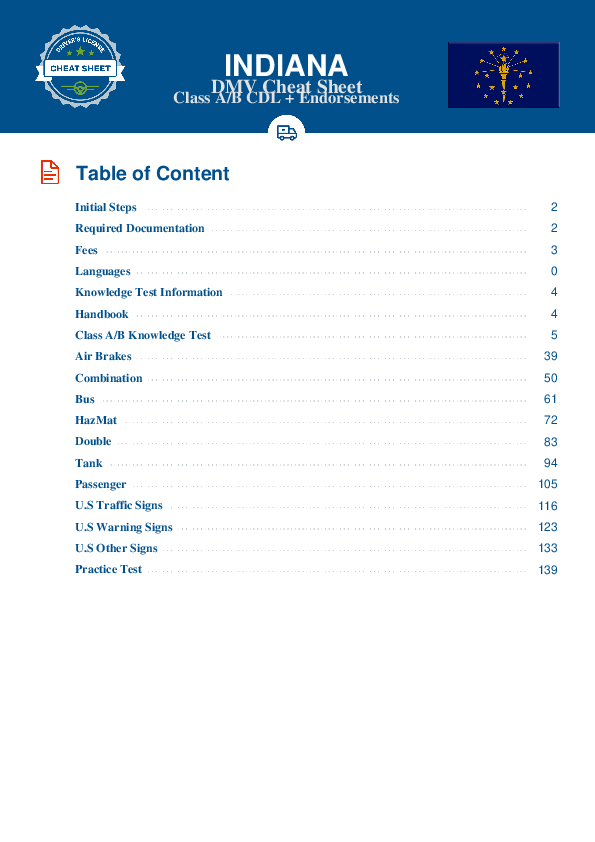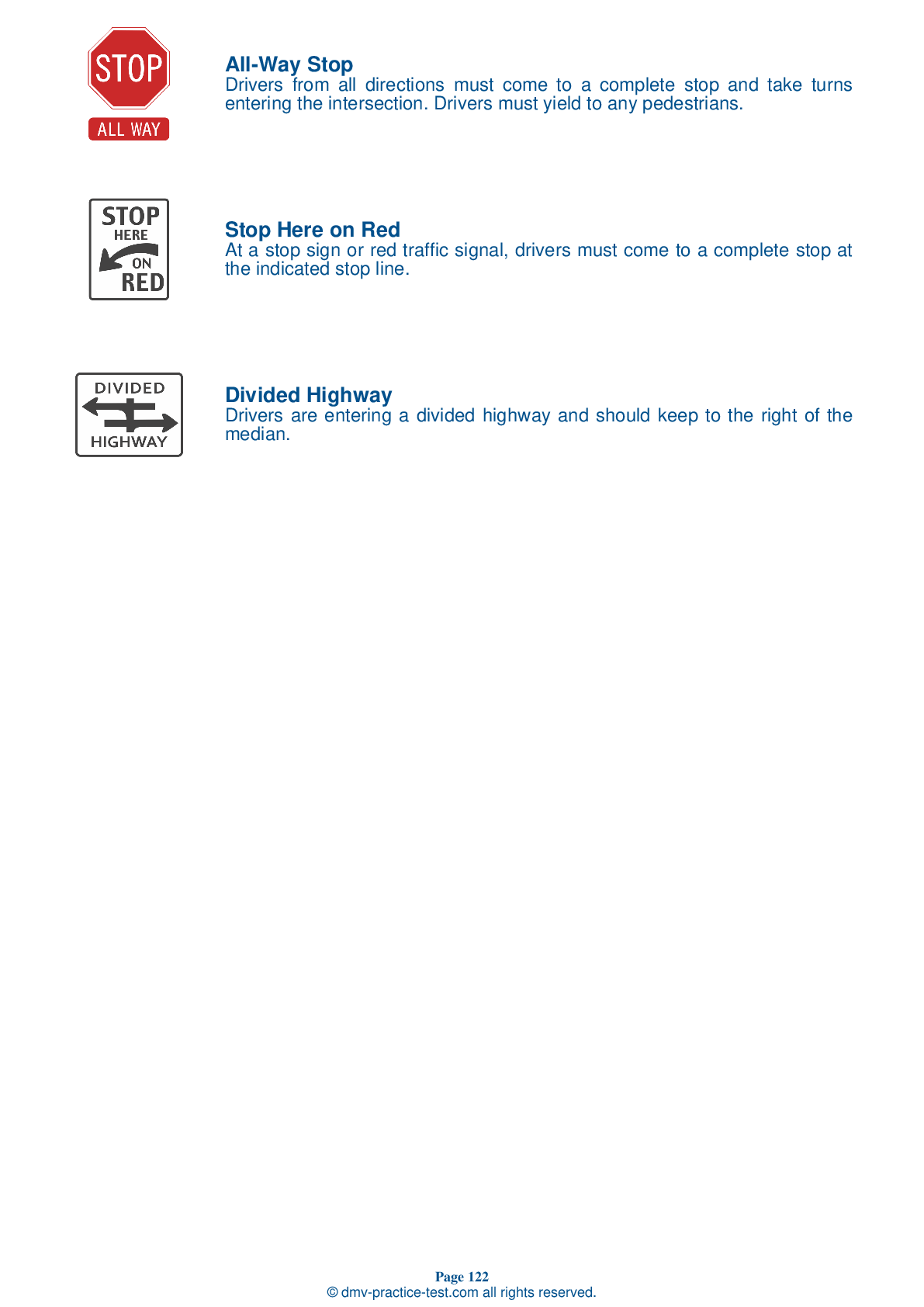Knowledge Test Class B #1
Class B Driving Test | Indiana 2025 #1 Page 5 of 7
Train for FREE online with our Indiana class B license test. The official exam test consists of several obligatory parts, with all of them checking your knowledge of different blocks of road rules. If you need to obtain a IN CDL class B permit in 2025, practice as much as possible. Free sample tests published on our website will help you check and improve your knowledge and boost your grades. Please bear in mind that CDL class B requirements may vary from state to state.
50
40
20
29 . If a load is 10 feet long, it should be secured by at least ____ tie-down(s).
Four
On flatbed trailers and trailers without sides, cargo needs to be tied down. There should be at least one tie-down for every 10 feet of cargo. Regardless of the size of the cargo, at least two tie-downs must be used.
30 . Which of the following is not a possible cause of a fire?
Rolling down the window
Possible causes of vehicle fires include spilled fuel or improper use of flares following an crash; under-inflated tires or dual tires that touch; short circuits in the electrical system; smoking around fuel; improper fueling or loose fuel connections; and carrying cargo that is flammable, improperly sealed or loaded, or poorly ventilated.
31 . When checking your tires, which of the following is not an issue to correct?
Tread depth of at least 4/32 of an inch on the front tires
Problems to check for when inspecting tires include: air pressure that is too low or too high; using radial and bias-ply tires together; tread depth of less than 4/32 of an inch in major grooves on front tires; and tread depth of less than 2/32 of an inch on all other tires.
32 . When asked about the vehicle's oil during the vehicle inspection test, you must be able to do all of the following, except:
Show that the oil level is below the refill mark.
During the vehicle inspection test, you must be able to indicate where the oil dipstick is located; show that the oil level is within a safe operating range; and show that the oil level is above the refill mark.
33 . Items on a flatbed:
Must be wrapped in plastic.
Cargo on a flatbed trailer or a trailer without sides must be secured to keep it from shifting or falling off during a trip. You should be aware of tie-down requirements for your particular cargo.
34 . You will be denied a hazardous materials endorsement if:
You have renounced your United States citizenship.
You will be denied a HazMat endorsement, or lose an existing endorsement, if you are not a lawful permanent U.S. resident; you renounce your U.S. citizenship; you are wanted for, under indictment for, or convicted of certain felonies; you are judged as mentally unstable or are committed to a mental institution; or you are deemed to pose a security threat by the Transportation Security Administration (TSA).
35 . Failing to exit your vehicle properly during an exercise in the basic vehicle control skills test will result in:
An extra point against your score.
When exiting your vehicle during the basic vehicle control skills test, you must face the vehicle and maintain three points of contact at all times. If your testing vehicle is a bus, you must maintain contact with the handrail. Exiting the vehicle incorrectly may result in automatic failure of the basic control skills test.
2025 Indiana | Frequently Asked Questions
To acquire a CDL Tank endorsement in Indiana, you must first have a Commercial Driver's License (CDL). Next, study the Indiana CDL handbook section on tank vehicles. Then, schedule and pass the Tank Vehicle Endorsement Knowledge Test at a BMV branch. Lastly, pay the required fee to add the endorsement to your license.
To obtain a CDL Tank license, it's essential to have a valid Commercial Driver's License (CDL). You must also pass the Tank Vehicle Endorsement Knowledge Test, which covers the special driving rules and techniques for tank vehicles. Studying the relevant section in the Indiana CDL manual can help prepare for this test.
While specific training isn't mandatory for a CDL Tank endorsement in Indiana, it's highly recommended. Having a solid understanding of the Indiana CDL handbook section on tank vehicles is crucial. Prior experience isn't required, but practicing with a professional driver or attending a driving school can increase your chances of passing the endorsement test.
Yes, in Indiana, to obtain a CDL Tank endorsement, you are required to pass the Tank Vehicle Endorsement Knowledge Test. This test is in addition to the general CDL knowledge and skills tests. Studying the tank vehicle section of the Indiana CDL handbook is crucial to pass this written test.
The written test for the CDL Tank endorsement in Indiana includes subjects like inspecting tank vehicles, driving tank vehicles, and safe driving rules specific to tank vehicles. It also covers the effects of liquid surge on vehicle handling, and knowledge about bulkheads and baffles. Studying these topics will help you pass the test.
The CDL Tank endorsement assessment in Indiana primarily focuses on knowledge rather than specific driving maneuvers. It tests your understanding of inspecting tank vehicles, driving them safely, handling liquid surge, and the function of bulkheads and baffles. However, the general CDL skills test will assess your actual driving abilities.
Yes, drivers with a CDL Tank endorsement must adhere to certain regulations. They must pass regular drug and alcohol tests, maintain a clean driving record, and follow hours-of-service regulations. Additionally, they must comply with special procedures for loading and unloading cargo, and avoid certain routes, like roads with low bridges or tunnels, due to the vehicle's size.
No, drivers cannot legally transport liquid or gas materials without a valid CDL Tank endorsement in Indiana. This endorsement is specifically required for operating a tank vehicle, which is defined as any commercial motor vehicle designed to transport any liquid or gaseous materials within a tank either permanently or temporarily attached to the vehicle.
Yes, the CDL Tank endorsement can be added to your current license. A fresh application isn't necessary. You need to pass the Indiana CDL Tank Vehicle written test, and once you do, the endorsement will be added to your existing CDL. Remember, there may be additional fees for adding endorsements.
Yes, there are specific regulations and prerequisites in place for handling hazardous materials with a CDL Tank endorsement in Indiana. These include passing a written test, undergoing a background check, obtaining a Transportation Security Administration (TSA) clearance, and completing specialized training on the safe handling and transportation of hazardous materials. Compliance with federal regulations, such as those outlined in the Hazardous Materials Regulations (HMR), is also required.



